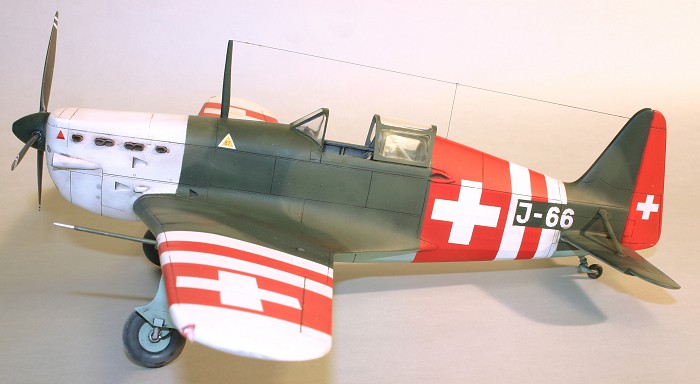
| KIT #: | AB 3201 |
| PRICE: | € 33.36 |
| DECALS: | Two options |
| REVIEWER: | Pierre-André Boillat |
| NOTES: | Transformed into a Swiss licence-built version |

| HISTORY |
As
the Morane-Saulnier MS 406 has been reviewed several times on this site, I
won’t spend too much time writing about its development and combat record.
To keep it short, let’s just say that it when it entered service in 1938,
it was the Armée de l’Air’s first modern monoplane fighter with an enclosed
cockpit and retractable landing gear. However, it soon became obsolescent
compared with more modern designs. In 1940 it was France’s most numerous
(but not best) fighter during the ill-fated campaign of may-june, and
soldiered on with the Vichy Air Force until 1942, battling against the
British in Syria and 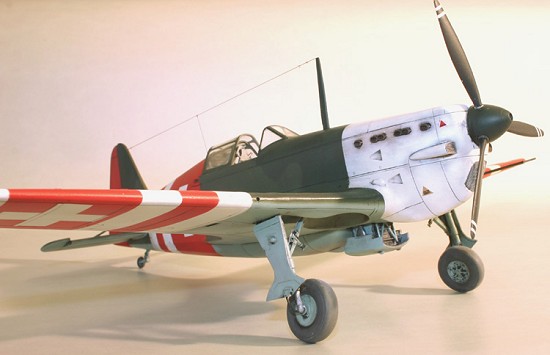 Madagscar. The Germans gave 46 captured Moranes to
Finland , where they performed pretty well (the Finns had a talent for
turning any aircraft into a winner). Some also saw service with the
Italian, Croatian and Turkish air forces (Turkey had purchased 45 before
the war). All in all, the Morane 406 had nothing to become a legendary
aircraft, but it was a sound design that could perform well in the hands of
a good pilot.
Madagscar. The Germans gave 46 captured Moranes to
Finland , where they performed pretty well (the Finns had a talent for
turning any aircraft into a winner). Some also saw service with the
Italian, Croatian and Turkish air forces (Turkey had purchased 45 before
the war). All in all, the Morane 406 had nothing to become a legendary
aircraft, but it was a sound design that could perform well in the hands of
a good pilot.
In 1939 (with rumours of war increasing every day), the Swiss federal military purchase commission managed to buy two Morane-Saulnier MS 406 C-1s straight from the factory, and delivered them to the “Troupes d’Aviation” (or “Fliegertruppe” – Swiss Air Force) for immediate evaluation. As the test results were excellent, a short negotiation took place with the manufacturer and the French government, and the licensed production of an 8-aircraft “pilot” (pre-prod) series was started the same year at the Federal Ordnance Factory (C+A) in Thun.
The operational tests performed with these 8 planes only led to minor modifications, the most important being the installation of a Swiss-made Escher-Wyss propeller to replace the original Chauvière, whose pitch-regulator was prone to break-downs. When all testing was completed, mass-production could start, and 74 Moranes were built by the Federal Aircraft Factory (F+W) in Emmen, Doflug in Altenrhein and SWS in Schliern under the D-3800 designation. The machines (including the two first and the pre-series) were coded J-1 to J-84.
Delivery to the Swiss fighter squadrons began in January 1940, and all D-3800s were operational by August of the same year. While the D-3800 production was running, a new 1’000 HP engine (the HS-51 12Y) was developed by Hispano-Suiza, and fitted to the Morane design. The resulting aircraft, known as MS-506 or D-3801 (easily recognizable because of its different radiator air intake and exhaust pipes), was 60 KmH faster and could climb 1’600 m higher than the original D-3800.
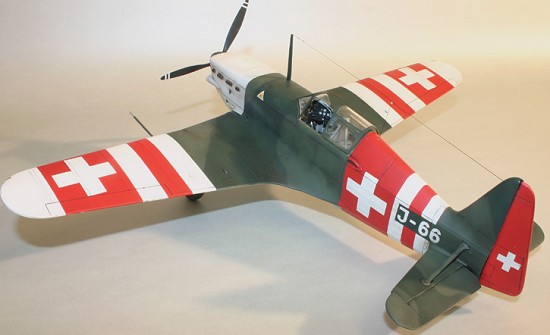 After some initial teething problems, the D-3801 would become
Switzerland's main fighter of the WWII-era, with 207 produced (coded J-91
to J-297). The Morane series were quite popular with their Swiss pilots.
While a better fighter was available (89 Bf 109 E-3s were also in Swiss
service), the Morane was appreciated because of its pleasant handling
characteristics and ruggedness… and because it would “forgive” slight
mistakes that would kill you in a Messerschmitt !
After some initial teething problems, the D-3801 would become
Switzerland's main fighter of the WWII-era, with 207 produced (coded J-91
to J-297). The Morane series were quite popular with their Swiss pilots.
While a better fighter was available (89 Bf 109 E-3s were also in Swiss
service), the Morane was appreciated because of its pleasant handling
characteristics and ruggedness… and because it would “forgive” slight
mistakes that would kill you in a Messerschmitt !
After faithfully patrolling the Swiss airspace during WWII (however, most actual combat against intruding Germans was performed by the Bf109 fleet), the D-3800 and D-3801s soldiered on as light attack planes, trainers and target aircraft until 1959.
Further developments, the D-3802 and D-3803 (which looked like the strange offspring of a Morane and a Mustang) were cancelled after a pre-serie of 11 planes (the D-3803 only reaching prototype status). They may have been the fastest Moranes ever (with a stunning speed of 640 KmH), but second-hand P-51s were purchased instead in 1948 (they were the better aircraft – and much cheaper, at that).
In 1949, Switzerland entered the jet-age with the DeHavilland Vampire. But this is another story…
| THE KIT |
Over 40 years, one cannot say that the Morane 406 has been a favorite of
kits manufacturers. In 1/72, Heller, Frog and Hasegawa have been the only
companies to offer one, the Hasegawa effort being the best to date
(however, its wing reinforcement ribs are
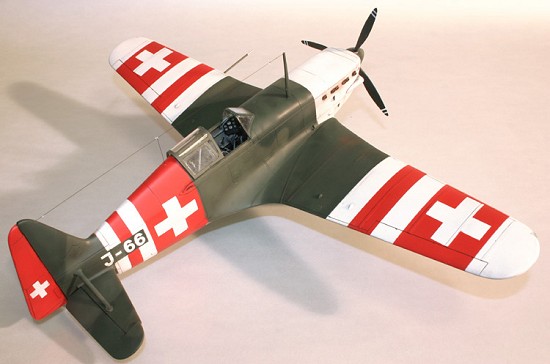 represented by engraved lines,
which is wrong) . In 1/48, two models have been produced by Hobbycraft and
Classic Airframes, both plagued by shortcomings. At last, Azur seems to
offer us a correct Morane 406… in 1/32, however, which unfortunately is
likely to limit its commercial success.
represented by engraved lines,
which is wrong) . In 1/48, two models have been produced by Hobbycraft and
Classic Airframes, both plagued by shortcomings. At last, Azur seems to
offer us a correct Morane 406… in 1/32, however, which unfortunately is
likely to limit its commercial success.
So, what comes in this well-illustrated box – that has been eagerly expected by many ?
64 crisply-molded medium-grey plastic parts, 13 clean resin parts, a photo-etched sheet with 26 parts, one film with the intruments printed on, and the clearest transparent parts I have ever seen (their optical quality is stunning). Unfortunately, as it would turn out later, they are too small (strange thing in a world where most everything comes “supersized”)…
As said above, the decal sheet provides 2 versions, both Armée de l’Air during the Battle of France : one machine of the GC I/2 “Cigognes”, and one of GC II/7. The colours seem perfect, and they are spot on register.
| CONSTRUCTION |
As soon as I opened the box, my decision was taken : this bird would become a D-3800. After studying my documentation, I noticed following things would have to be modified :
-
The gun fairings on the wings
must be removed, and new case ejector ports have to be made. MG muzzles
are simple holes in the wing leading edges.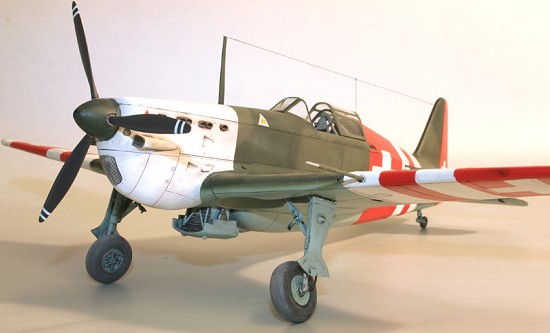
- The propeller hub’s tip has to be flattened and the cannon’s muzzle has to be drilled open. Fortunately, the Swiss propeller is very similar to one of the two sets of prop blades included in the box.
- The tail skid has to be replaced with a tail wheel (from the spares box).
- The antenna mast is placed elsewhere (on top of the windshield, or on the cowling, depending on the year of service). The “cowling” option will require a new, longer mast.
As you see, no big deal.
After filling the gun fairings with putty from inside (as to avoid unpleasant surprises), I filed these out, then drilled and filed out the new ejector ports. Having done this, I started with the cockpit, which is very complete thanks to the numerous photo-etched parts. In fact, it’s a little model of its own. Don’t follow the painting instructions (which are given in Humbrol references). Swiss Moranes have light grey interiors with black instrument panels. It seems the seat was aluminium. As the transparent film part bearing the instruments was printed black, I had no choice but to represent white instruments – I guess it must be wrong, but as the only pictures I saw are from restored machines, I can’t be sure.
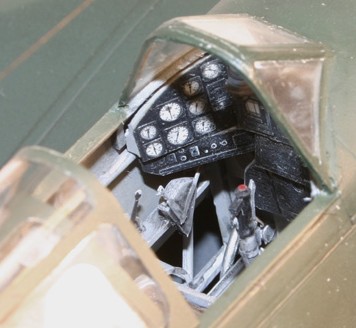 The plastic is very soft. That is quite nice on a short-run kit where fit
can be so-so (you can easily force the parts in shape without breaking
anything). Yet, beware of not damaging the surfaces.
The plastic is very soft. That is quite nice on a short-run kit where fit
can be so-so (you can easily force the parts in shape without breaking
anything). Yet, beware of not damaging the surfaces.
Main assembly
One of the few shortcomings of this kit is the absence of locating pins and quite a lot of flash – however, once the parts are cleaned, things will improve dramatically. Just dry-fit everything, and it should go fine. If some parts are slightly warped (due to the soft material), just tape them in place until dry or help out with superglue.
The cockpit bit fits very well into the fuselage, which itself assembles without problems (just be cautious not to forget to add the nose grille and resin exhaust pipes before you glue it together).
The wing and tailplane require a little more work. Especially the wing part, which will have to be cut and filed to fit the fuselage.
All in all, a respectable result for a short-run kit. Yet, putty will be necessary everywhere to hide the seams (but especially on the wing-fuselage joint), so a good sanding job awaits you. The good news is that only few panel lines will be touched, so the ensuing rescribing work will be kept to a minimum.
Disaster strikes !
As mentioned above, a quick dry-fit proved that the transparent parts are pretty undersized. Clumsy as I am I, managed to break the windshield in two when I tried to make it fit !
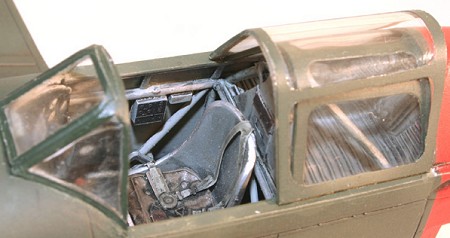 After the usual cussing session (and two unsuccessful attempts at cutting
a new one from rhodoïd), I chose a completely new option : I cut the broken
middle part off with a motor tool, kept the side windows, made a slightly
bigger new windshield from an audio-cassette’s Plexiglas case, adjusted it,
then assembled the three parts of the front canopy before starting the
painting job (in fact, I did this twice because I stained the first
windshield with glue…). I’m quite amazed to see how good this desperate
rescue operation turned out.
After the usual cussing session (and two unsuccessful attempts at cutting
a new one from rhodoïd), I chose a completely new option : I cut the broken
middle part off with a motor tool, kept the side windows, made a slightly
bigger new windshield from an audio-cassette’s Plexiglas case, adjusted it,
then assembled the three parts of the front canopy before starting the
painting job (in fact, I did this twice because I stained the first
windshield with glue…). I’m quite amazed to see how good this desperate
rescue operation turned out.
True, the new part is a little thicker than the rest, but as the D-3801s and most D-3800s were retro-fitted with an armored windshield, it even adds realism to the model…
As for the rear and sliding part, they are still undersized (and don’t fit together), but if you represent the canopy open, it won’t show (and all of that exquisite cockpit detail will remain visible).
| COLORS & MARKINGS |
During
the great allied bomber offensive against Germany, on of the main tasks of
the Swiss fighter force was to intercept and escort disabled allied bombers
to Swiss airfields, where they would be interned for the duration. After
several incidents 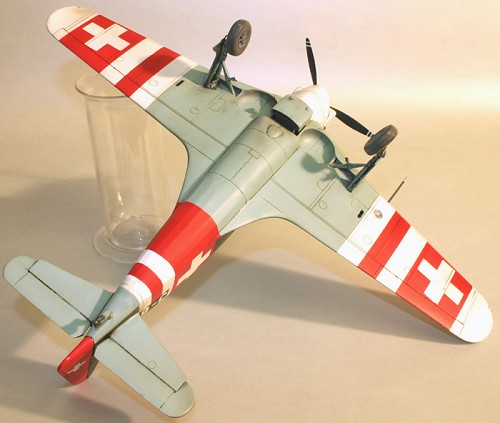 with nervous American gunners, Swiss aircraft were
painted in the so-called “neutrality scheme”, a high-visibility pattern of
red and white stripes on the wings and fuselage, with an all-white cowling.
The camouflage was ruined, but at least the US or British airmen knew at
first sight they didn’t have to deal with the Luftwaffe (this was
especially vital for the Swiss Messerschmitt pilots).
with nervous American gunners, Swiss aircraft were
painted in the so-called “neutrality scheme”, a high-visibility pattern of
red and white stripes on the wings and fuselage, with an all-white cowling.
The camouflage was ruined, but at least the US or British airmen knew at
first sight they didn’t have to deal with the Luftwaffe (this was
especially vital for the Swiss Messerschmitt pilots).
Being fond of colourful markings, I chose to represent the D-3800 coded J-66 as it flew in 1944, in full neutrality pattern. As no decals whatever are available to do this, my only option was to paint the whole thing. Fortunately, I have a large cutting plotter at the office, which allowed me to cut accurate masks out of adhesive foil (the codes and Swiss crosses were first designed on Corel Draw with pictures of an actual machine as an example, then translated on the plotting program). It was my first attempt at producing masks this way, and the method worked extremely well (I just had to use a cheap “short-life” foil that doesn’t stick too much). I’ll keep on using it on large scale models.
After painting and covering the red and white patterns and markings, the regular Swiss camo of RLM 70/71/65 was applied (apparently, Switzerland bought its colours from Germany).
After applying and polishing off a wash of dark oils (easy on weathering, folks, a Swiss military aircraft is supposed to be quite clean !), I could go to the next step.
| FINAL BITS |
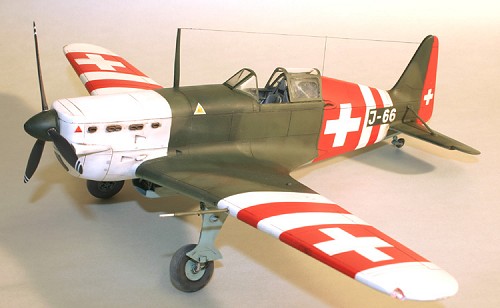 Installing
the landing gear (with its typical inside-looking wheels) went without a
problem. Just don’t forget to add the little retraction wires as shown on
the plan. In this big scale, I also represented the brake pipes. The prop,
along with its modified hub, assembles very well. As said before, I made a
new, longer antenna mast from scratch and installed it on the cowling. As
seen from the pics, radio wires installation on Swiss Moranes can vary a
lot between individual machines or service years. The wiring itself was
made from streched sprue, with Krystal Klear isolators.
Installing
the landing gear (with its typical inside-looking wheels) went without a
problem. Just don’t forget to add the little retraction wires as shown on
the plan. In this big scale, I also represented the brake pipes. The prop,
along with its modified hub, assembles very well. As said before, I made a
new, longer antenna mast from scratch and installed it on the cowling. As
seen from the pics, radio wires installation on Swiss Moranes can vary a
lot between individual machines or service years. The wiring itself was
made from streched sprue, with Krystal Klear isolators.
After several layers of matt lacquer were applied – I also made a light post-shading in the original camo-colours - the remaining transparencies were eventually attached (I had to glue the rear canopy in shape so it fits to the fuselage opening), and subtle exhaust stains were made with pastel powder.
Et voilà – I can proudly add an important Swiss aircraft to my collection.
| CONCLUSIONS |
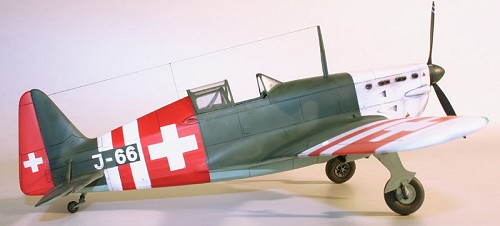 OK, it’s not everyone’s pet aircraft, it’s not shake-and-bake, and it
required a lot of research, as well as a lot of putty and sanding paper
(plus NERVES, if I think back of the windshield incident). But it’s far
from being difficult or even tricky. I guess the modellers willing to stay
with the french versions will even find it quite easy.
OK, it’s not everyone’s pet aircraft, it’s not shake-and-bake, and it
required a lot of research, as well as a lot of putty and sanding paper
(plus NERVES, if I think back of the windshield incident). But it’s far
from being difficult or even tricky. I guess the modellers willing to stay
with the french versions will even find it quite easy.
But hey – it’s a 1/32 D-3800, a piece I wouldn’t have fancied even in my wildest dreams only a few months ago. And the final result has the looks and the feel of the real one… so it definitely was worth the whole work. I love this kit.
To quote Droopy : “You know what ?... I’m happy”
PS: highly recommended. Now please, Mr. Azur, pantograph it down to 1/48… and add a D-3801 !
October 2005
| REFERENCES |
« Les avions des troupes d’aviation suisses depuis 1914 », Verlag Th. Gut&Cie, 1974
« Mach 1 – encyclopédie de l’Aviation », Editions Atlas, 1979
« French fighters in action », Squadron Signal « In Action » series Nr. 180
Various Internet research.
If you would like your product reviewed fairly and fairly quickly, please contact the editor or see other details in the Note to Contributors.